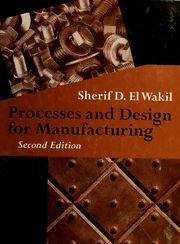
Processes and design for manufacturing PDF
Preview Processes and design for manufacturing
I SherifD.ElWakil Processes and Design for Manufacturing Second and Design Processes Manufacturing for Second Edition SherifD. ElWakil University ofMassachusetts Dartmouth WAVELAND PRESS, INC. ProspectHeights, Illinois memory ofMamdouh El-Wakil, M.D., Ph.D. To the For information aboutthis book, contact: Waveland Press, Inc. P.O. Box 400 Prospect Heights, Illinois 60070 (847)634-0081 www.waveland.com Copyright © 1998 by SherifD. El Wakil 2002 reissued by Waveland Press, Inc. ISBN 1-57766-255-5 Allrights reserved. Nopart ofthis bookmaybereproduced, storedin aretrievalsystem, ortransmittedin anyform or by anymeans withoutpermission in writingfrom thepublisher. Printed in the United States ofAmerica 7 6 5 4 3 2 1 1 Chapter 1 Overview 1 INTRODUCTION 1.1 Definition ofManufacturing 1 1.2 Relationship Between Manufacturing and Standard ofLiving 2 1.3 Overview ofthe Manufacturing Processes 2 1.4 Types of Production 3 1.5 Fundamentals of Manufacturing Accuracy 4 1.6 The Production Turn 6 1.7 Product Life Cycle 7 1.8 Technology Development Cycle 8 1.9 The Design Process 10 1.10 Product Design: The Concept ofDesign for Manufacturing 14 Review Questions 16 Chapter 2 Concurrent Engineering 17 INTRODUCTION 2.1 Reasons forAdopting Concurrent Engineering 19 2.2 Benefits ofConcurrent Engineering 20 2.3 Factors Preventing the Adoption ofConcurrent Engineering 2 2.4 The Four Pillars ofConcurrent Engineering 22 2.5 Forces ofChange 24 2.6 A Success Story: Nippondenso 30 Review Questions 32 iii iv Contents Chapter 3 Casting and Foundry Work 33 NTRODUCTION I 3.1 Classifications ofCasting by Mold Material 34 3.2 Classifications ofCasting by Method ofFilling the Mold 52 3.3 Classifications ofCasting by Metal to be Cast 58 3.4 Foundry Furnaces 63 3.5 Casting Defects and Design Considerations 68 3.6 Cleaning, Testing, and Inspection ofCastings 72 3.7 Castability (Fluidity) 75 Review Questions 76 Design Example 78 Design Projects 81 Chapter 4 Joining of Metals 84 NTRODUCTION I 4.1 Riveting 84 4.2 Welding 84 4.3 Surfacing and Hard-Facing 120 4.4 Thermal Cutting of Metals 121 4.5 Brazing and Soldering 123 4.6 Sticking ofMetals 128 Review Questions 130 Problems 133 Design Example 133 Design Projects 137 Chapter 5 Metal Forming 139 NTRODUCTION I 5.1 Plastic Deformation 140 5.2 Rolling 145 5.3 Metal Drawing 155 5.4 Extrusion 158 5.5 Forging 176 5.6 Cold Forming Processes 201 Review Questions 204 Problems 207 Design Example 207 Design Projects 209 Contents Chapter 6 Sheet Metal Working 211 INTRODUCTION 6.1 Press Working Operations 212 6.2 High-Energy-Rate Forming (HERF) 238 6.3 Spinning of Sheet Metal 241 Review Questions 242 Problems 244 Design Example 245 Design Projects 246 Chapter 7 Powder Metallurgy 248 INTRODUCTION 7.1 Metal Powders 249 7.2 Powder Metallurgy: The Basic Process 254 7.3 Operational Flowchart 258 7.4 Alternative Consolidation Techniques 258 7.5 Secondary Consolidation Operations 263 7.6 Finishing Operations 264 7.7 Porosity in Powder Metallurgy Parts 266 7.8 Design Considerations for Powder Metallurgy Parts 268 7.9 Advantages and Disadvantages of Powder Metallurgy 270 7.10 Applications ofPowder Metallurgy Parts 270 Review Questions 274 Problems 275 Design Project 277 Chapter 8 Plastics 278 NTRODUCTION I 8.1 Classification ofPolymers 279 8.2 Properties Characterizing Plastics and Their Effect on Product Design 282 8.3 Polymeric Systems 283 8.4 Processing of Plastics 291 8.5 Fiber-Reinforced Polymeric Composites 303 References 328 Review Questions 328 Design Projects 330 vi Contents Chapter 9 Physics of Metal Cutting 331 INTRODUCTION 9.1 Cutting Angles 332 9.2 Chip Formation 334 9.3 Cutting Forces 339 9.4 Oblique Versus Orthogonal Cutting 343 9.5 Cutting Tools 348 9.6 Machinability 353 9.7 Cutting Fluids 354 9.8 Chatter Phenomenon 356 9.9 Economics of Metal Cutting 356 Review Questions 358 Problems 359 Design Project 360 Chapter 10 Machining of Metals 361 INTRODUCTION 10.1 Turning Operations 362 10.2 Shaping and Planing Operations 379 10.3 Drilling Operations 382 10.4 Milling Operations 392 10.5 Grinding Operations 400 10.6 Sawing Operations 405 10.7 Broaching Operations 407 10.8 Nontraditional Machining Operations 408 Review Questions 411 Problems 413 Chapter 11 Product Cost Estimation 415 INTRODUCTION 11.1 Costs: Classification and Terminology 416 11.2 Labor Cost Analysis 418 11.3 Material Cost Analysis 421 11.4 Equipment Cost Analysis 423 11.5 Engineering Cost 425 11.6 Overhead Costs 425 11.7 Design to Cost 427
